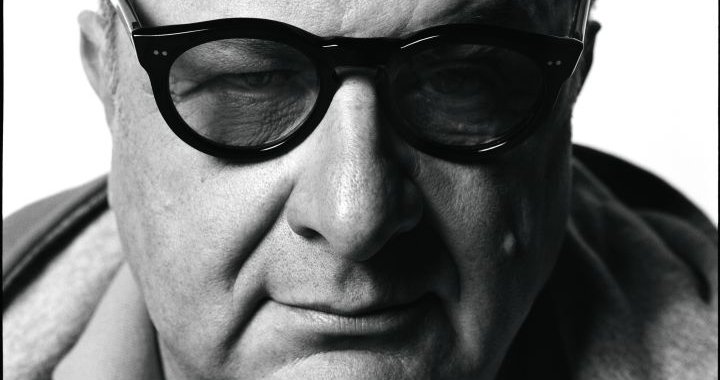
Pigozzi - a visionary of life
An interview with Jean Pigozzi, art collector and entrepreneur
15/09/2015
If Jean Pigozzi were the main character in a novel, one might think the author had exaggerated a bit, because one person is just not capable of doing so much in one lifetime. But yes, one can! The classic descriptions – businessman, investor, photographer, collector, patron of the arts, philanthropist, etc. – simply do not suit the man. Pigozzi is a person with planet-level scope, or, as Vanity Fair once aptly called him, he's “Planet Pigozzi”. The one thing Pigozzi hates above all else are well-trodden paths, whether they be in business or art. While other millionaires collect Warhol and Basquiat, over the past 20 years Pigozzi has created the largest collection of contemporary African art in the world. And, while the fashion world is obsessed with the illusion of eternal youth, Pigozzi has created the unbelievably successful fashion brand LimoLand, which produces garments for “old, rich men”. Men like Pigozzi himself – large in all senses of the word.
Pigozzi was born 62 years ago into an Italian family living in France. His father was an auto manufacturer who created the popular French automobile Simca in the late 1950s. At age 11 Pigozzi found out he was born to a surrogate mother, his father died when he was only 12 years old, and at age 21 he claimed his inheritance, which allowed him to forever after rise above the existential worries of everyday life. During his school years he was accused of all kinds of misdeeds, including laziness, but he was nevertheless accepted at Harvard University. He still tells of the event as a funny story. He had not done very well on the entrance exams, but he lucked out that his interviewer was a Parisian banker who, having found out about Pigozzi's Italian roots and that his family was originally from Turin, said he would pose him two questions. If Pigozzi answered correctly, he would be accepted into Harvard. The first question was “What's the best restaurant in Turin?” The second question was “When is truffle season?” Pigozzi answered both and was accepted into Harvard. “That's the one-hundred-percent truth,” he says.
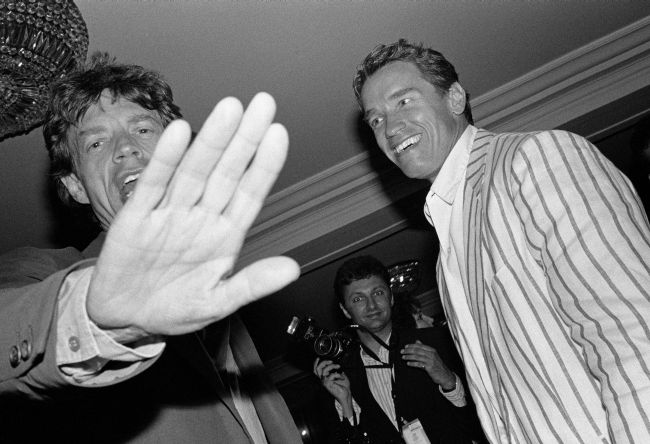
Mick Jagger and Arnold Schwarzenegger, Cannes, 1990. © Jean Pigozzi
After being diagnosed with dyslexia as a child, Pigozzi turned to documenting his life in photographs. Since then, he and his camera have been inseparable. And, because his life revolves around the global glamour orbit, he has become one of the best documentarians of the elite circles of his time. Mick Jagger, Andy Warhol, Steve Jobs, Michael Douglas, Bill Gates, Kate Moss, Charles Saatchi, Larry Gagosian, Martin Scorsese, Bono...it's almost impossible to find someone who has never found him/herself near Pigozzi's camera. When Vanity Fair published its 2008 list of the 100 most influential people in the world, they also included a chart showing how each of them were associated with Pigozzi. “Sophisticated snapshots” is how Pigozzi calls his pictures, which candidly record moments that might be witnessed only by a good friend or trustworthy acquaintance.

© Hiroki Tsukuda "Sea Gate," 2010
Exhibitions of Pigozzi's photos have been shown at the Helmut Newton Foundation in Berlin, the Gagosian Gallery in New York City, the Multimedia Art Museum in Moscow, the Arles photography festival and even in Beijing earlier this year. His collection of contemporary African art has been exhibited at the Guggenheim Museum in Bilbao, London's Tate Modern, the Grimaldi Forum in Monaco and elsewhere. A few years ago Pigozzi began collecting artwork by young Japanese artists. JapanCongo, an exhibition of both African and Japanese art from Pigozzi's collection, curated by Carsten Höller, was shown in 2011 in Grenoble, Moscow and Milan's Palazzo Reale.
Pigozzi owns homes in France, Switzerland, New York City and Panama as well as a former fishing boat turned into a yacht called the Amazon Express. He has invested millions in high-tech companies, including Facebook. Another of his extravagant projects, the Liquid Jungle Lab ocean and jungle research centre, is located on his private island in Panama. In early September the American TV channel Esquire Network began an eight-episode series called My Friends Call Me Johnny, in which Pigozzi travels the world and asks provocative questions of his artist, director and actor friends and others. “You have to be curious,” he says. “Every day in your life you have to go out and learn something new. The day when you stop being curious, you can close down your shop, it's finished.”
The morning we meet at Villa Dorane, which Pigozzi's father built in the 1950s at the very tip of Cap d'Antibes and whose interior Pigozzi later redesigned with the help of Ettore Sottsass, Pigozzi greets me in bare feet, shorts and a striped shirt. He introduces me to his “cousins” – wooden sculptures located right by the home's entry and painted by the African artists Emile Guebehi and Nicolas Damas. “They're from Ivory Coast.” It's already 11 o'clock and Pigozzi has not yet had breakfast. We sit on the terrace and gaze upon a view of the Mediterranean worthy of a postcard; white yachts slide across the water in the distance and the cicadas chirp away like crazy. Pigozzi eats a breakfast of salmon and a green salad, and now and then some of his many guests leisurely crawl out of their rooms to join us. Among them is a Chinese woman with skin like a porcelain doll's who knows all of the prominent collectors of Chinese art. Among them is also the first lady of fashion PR, whose clientèle includes Karl Lagerfeld and Jean Paul Gaultier. There is hardly a moment when Pigozzi has no guests at Villa Dorane. The guests' daily menu is written on a separate chalkboard in the kitchen.
We talk for more than an hour and Pigozzi shows me his recent photos of Bono. But the gentle giant can no longer sit still in his chair, so he offers to show me the house. However, the house contains only a small part of his African collection; the rest of the artwork is stored in a hangar at the Geneva airport. Almost all of the paintings and photographs have frames made by Sottsass. South African artist Esther Mahlangu has painted the staircase leading to the second floor in bright colours. I can hardly spot the desk (also designed by Sottsass, like the rest of the furniture at Villa Dorane) amidst all the the papers, books and various piles of creative chaos in Pigozzi's office. When I ask him how he manages to find anything in the office, Pigozzi answers, “Easy. I know where to look. I'm always suspicious if a person's office is too sterile. That means that the mess is probably in his head. Whereas mine is very clean.” Be that as it may, but one can certainly not reproach Pigozzi for lacking a clear vision in everything he does.
You once said that collecting is an “incurable disease”? Is it really so?
Yes. You know, if you have a problem with alcohol, you can go to Alcoholics Anonymous or you can go cure yourself from drugs, but there's nothing you can do for collecting. Except if you have no more money, which is possible. Or you have no more space, which is also possible. This year I am doing an experiment. I'm not buying any art for an entire year. But I already cheated; I've already bought three pieces of art. But I used to buy many. This year I didn't go to the Basel art fair.
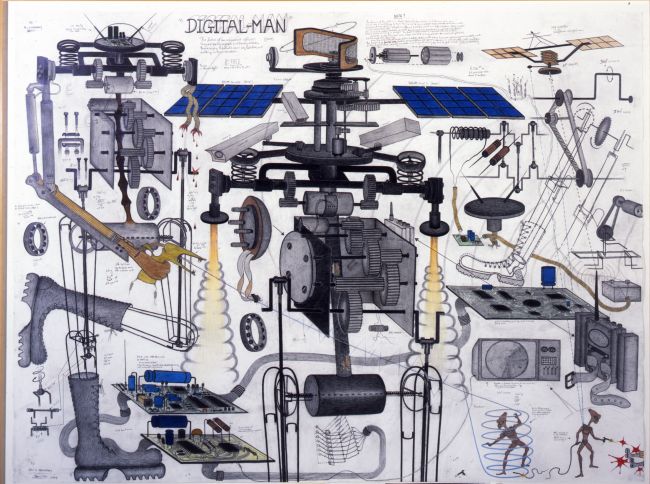
Abu Bakarr Mansaray. Digital Man, 2004
For the first time?
Yes, the first time in 25 years. I just decided “why not”? You know, I once tried to not eat chocolate for one year and I survived. So I want to see the effect if I don't buy art for one year – will I survive? I'm OK.
Does that mean you're starting to cure yourself from this disease?
No, no. On January 1st next year I will start again. This is just an experiment.
Do you remember when you caught the first symptoms of collecting?
I was very, very young. When I was nineteen years old I used to go to galleries in New York. I think the first thing I bought was a little drawing by Sol Lewitt. Back then it cost like five hundred dollars. But that was a lot of money, actually. That was the first thing I bought. I bit later I bought a great drawing by Ed Ruscha at the Los Angeles County Museum art fair. It had an ugly frame. Years later I showed it to Ed and he said, “Oh yes, it's a very bad frame, but I made it myself. Keep the frame; this is a good frame.” I bought some other things afterwards, but I started to buy art really seriously 25 years ago after the Magiciens de la Terre show at the Centre Georges Pompidou in Paris. I went there on the day they were closing the show. I was there at 4:30pm and they were closing at 5:00pm, and when I saw this interesting and unusual stuff from Africa, I was very impressed. You know, when people think about African art, it's mainly about wooden sculptures, gold masks, etc. When I saw these incredible paintings and other things, I was so surprised that I went to Bobo the next day and said that I would like to buy some African things. They said to me that no, I could not buy them because they were owned by a French TV station. But if I wanted, they could introduce me to the curator. I said OK. I met this guy, André Magnin, and I hired him. Over the next 22 or 23 years we built together one of the largest collections of contemporary African art in the world, I think. And I hope it's the best one, too.
I was never interested in buying Warhol or Basquiat; that's too easy. If you have a lot of money, you can go and buy. Financially I made a mistake, because buying art by very young African artists was not a good idea. But culturally I think my choice is more interesting. Because when I started, everyone thought that I'm an idiot. But now many museums – like Pompidou, Tate, Metropolitan in New York, Los Angeles County Museum – they all want to do shows from my collection.
Does that mean that its value has also grown?
Not until the Africans start buying paintings, until the local people start buying paintings.... Like in China, the Chinese artists cost a lot of money because the rich Chinese collectors are buying them. But until the locals buy their own art, it's very difficult. You know, the very rich Africans, when they have money now, they buy Mercedes or big Rolexes with diamonds or build big houses with marble columns. Artwork by African artists costs 2000 to 3000 dollars, but they don't buy it. They don't understand it yet.
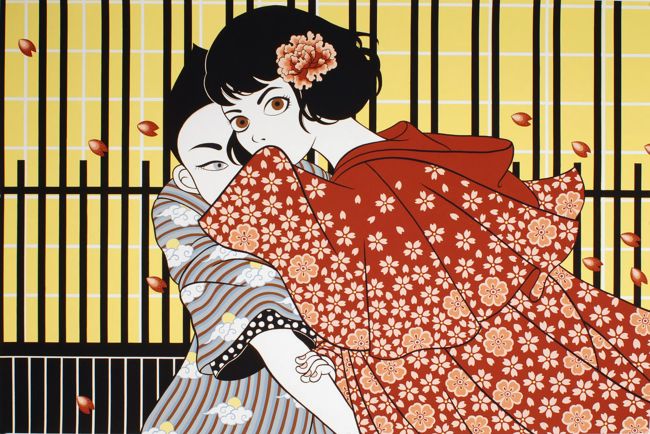
© Asuka Ohsawa - "Spring Love #1 (Petals)", 2008-2009
Do you think the situation is changing?
It will change eventually, but it takes years. You remember rich Americans, they used to buy impressionists; they did not buy American paintings. For years and years. Also the Japanese, they bought impressionists. It's a cultural thing, it takes time. First you always want something from the outside and it always takes many years to change. But it's OK, I don't care. I didn't do it for financial reasons; I did it because I saw that nobody else was interested and I thought it was a very interesting thing to do.
Africa was a centre of old culture. People have forgotten that. They look at old African things made before 1900, but they're not interested in the modern times. That was what attracted me to do this collection, and also because the art itself was very interesting. I will tell you what I like the most: none of these artists went to art school, they didn't know who Renoir was, they didn't know who Warhol was.... That was even before the Internet. Their inspiration really came from inside or it came from a few things they saw on TV or in magazines. All the other painters in other countries, they know everything. The first paintings I bought were made with paint used to paint cars. Really bad paint, it cracked. They also painted on sheets; they had nothing. But they were very interesting. One of the artists made his works only from things he found on the streets. A kind of ecology.
I suppose it has changed a lot since those days?
Not really. My rules were very simple: the artists have to be alive, they have to be black, and they have to live in Africa. There are a lot of black artists of the African diaspora who came to London and other European cities; they are not in my collection. They have to follow the rules. A lot of African artists who came to Paris, they went to Bobo, but I'm interested in those who stayed in Africa.
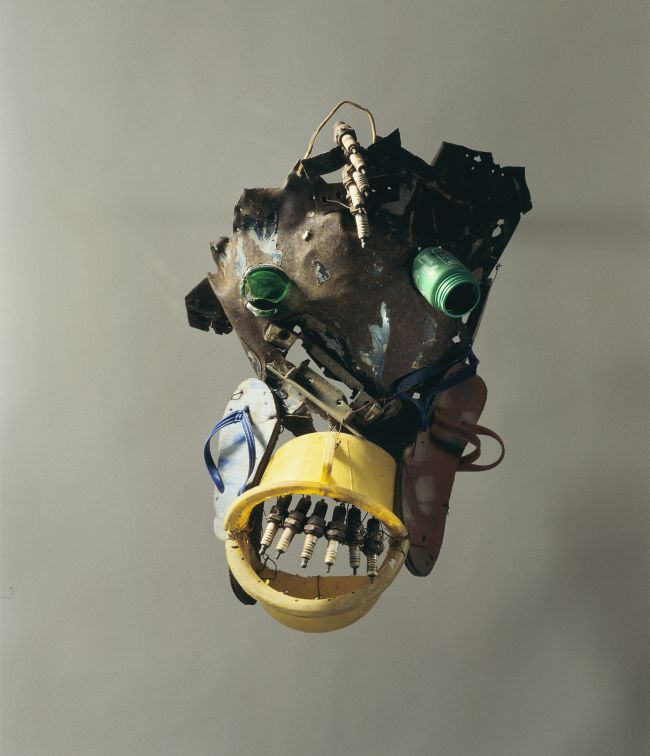
Calixte Dakpogan. La mort debout. Resuscitated, 2002
But how did you find them? You've never been to Africa yourself.
No. André goes often. It's very, very hard. If somebody says, “I want to start a contemporary art collection in New York,” they can go up and down Madison Avenue, go to Soho, and in two months' time they can create a collection. But if somebody wants to start an African collection, it will take years and years. Because they disappear, they get sick, they change residence. And when you receive pieces in Europe, they are already broken or full of little animals. It's really, really complicated. It's really a story of love, not about money.
How many pieces do you have now?
More than 10,000. I have a few things here, at home. I will show you later. And conservation is a big problem, restoration. The materials are bad. It's a lot of work.
This means that a part of your collection has already been irretrievably lost?
Sure, but that's normal. Many of the other artists' paintings also have to be restored, that's normal. If you buy statues made of marble, sometimes the nose breaks off. It's the same thing.
But you've never wanted to meet the artists yourself?
I know many of them, because they've come to America or Europe for shows. Some of them I don't know, but many of them I know. And I speak with them and I work with them. That's the very interesting part, to meet the artists and to talk with them. You know, a lot of people now, they never meet the artist, because when you go to the gallery there is some very young boy or girl who makes a speech – the artist wanted to say this, wanted to say that.... But actually you don't know anything, and then you meet the artist and he says, “I didn't say that. I, eh, I just did this painting because it was fun and these were the colours I used.” But then you have that experience. When you meet the artist, the feelings are very different.

Malick Sidibé. Nuit de Noël (Christmas Eve), 1962
Not in vain do some collectors feel it is very important to befriend the artists....
Yes, yes. I was very good friends with Andy Warhol, but when I hear now what Warhol was like, it's very different. I was very good friends with Basquiat, too. One day when I went to see Basquiat, he was doing paintings with Xerox colour and he said, “You know, I really want to buy that suit from Comme des Garçons.” The suit cost about a thousand dollars and the painting he was doing was quite big. I said: “I'm gonna buy a painting made with Xerox colour? That's idiotic!” And I didn't buy this painting. Now, the painting would be worth 30 million dollars or something like that. I didn't buy it. I make a lot of mistakes.
Do you regret your mistakes?
Ya, ya.... I regret them all, but it's OK. But, speaking of Warhol. When I met Warhol in 1972 or 1973, his paintings already the cost like 20,000 or 30,000 dollars. I went to Harvard, and at that time one year at that school cost 7500 dollars. I had no money, I couldn't buy them. It was a regret, but sometimes you have no money to buy everything. The prices maybe weren't always logical, but Warhol was a genius; he was so friendly, so nice, one of the big artists of all time. No way.
Was he really a genius?
One hundred percent. He had a very strange system of working. I didn't know the first Factory; I knew the second Factory. An entire week he had these lunches where he invited rich old ladies and other people. He was trying to do their portraits. I think it was 25,000 dollars and you get three or four portraits, and that's how he financed his other activities. And I asked him, “Andy, but when do you paint?” Andy said, “You know, I paint on Saturday and on Sunday, because nobody is here and I can work.” One day I went to see him at the weekend, he was on the floor, painting, and he said, “I'm happy to see people.” But you couldn't understand this guy, because you saw only these not very good paintings. They were OK, but they were not so great. His other works were unbelievable, but they didn't sell so well. And it was always like that.
The first and the only good painting by Basquiat I bought from him for 2500 dollars and I still have it.
And you are not going to sell it?
No way.

Romuald Hazoumé. On / Off, 1992
What do you consider to be the gems of your African collection? Which artists have you discovered?
I have discovered many artists. Like Chéri Samba. He is from Congo. I think he is one of the greatest painters in Africa. Photographer Seydou Keita; we are doing a big show at Grand Palais in September and October, during the photography month. Lilanga is also a great painter. There are many.
You once compared Keita with Richard Avedon.
Yes, I think he is Richard Avedon, or, I think he is even more like the Irving Penn of Africa. Absolutely. But you know, the main thing was that this guy always took only one photograph. Fashion photographers, they always take 300 photographs, bet he just made one click of the camera and that was it. And he achieved everything with it. He was really incredible; he understood light, and 90% of his best photographs were taken in the studio he had in his house with only natural light. A really amazing photographer.
I met him twice. Once in Paris and once when we had his show at the Gagosian gallery in New York and he came. You know, he used just small negatives and then he made contact sheets. And he never saw the bigger pictures. At the Gagosian show we had 1.80-metre pictures. He was shocked, but he liked them. He signed them and sold them. He was very happy. For the show in October next year we will have a lot of big pictures. New ones nobody has ever seen. New prints.
What are you planning to do with your collection?
If I was Bill Gates, I would build a museum. But I'm not Bill Gates. So, I'm open to suggestions. But I think what I might do is to divide it in pieces to give to different museums. I don't want to sell it. Maybe I will give some of it to Pompidou, some to Tate, some to Metropolitan, MOMA, different places.
Have you never thought of opening an art space in Panama, where you already own an ocean research laboratory? Like David Walsh did in Tasmania?
There is a woman in New York, I won't say her name, she had a very, very good collection and she opened a really nice place in the middle of America. She has two visitors per week. But she really has good things. If you don't put a museum in the middle of a big city, nobody comes. Even if it's only the distance of three stops on the subway. It's not worth it. I want people to see art.
I don't know if you noticed – along the way here is a small abandoned building that belongs to the French government. I wanted to do something with it, but they had no interest. In the end, they might start a flower research centre there. I went to see the mayor and said, “Do you know about Bilbao?” He said, “Bill who?”
Do you think the Bilbao Effect is still possible? So much has changed since then.
Yes, nobody went to Bilbao before the museum, but today people keep going there. A big museum was recently built in Baku. The Arab nations are also building unbelievable museums. But, no doubt, there are too many museums, too many art fairs; the art world has become ridiculous now. It's like the fashion world. There is a fashion week in Milan, but there is also a fashion week in Rio, in Sidney. You could go to a fashion week every day of the year. And the same with art fairs. There is an art fair in Dubai, an art fair in Torino, etc. I don't understand how people have enough walls to put all of this art. But it's OK.

Jean Pigozzi's Pool, Antibes, 2014. © Jean Pigozzi
Why do you think people are willing to pay unbelievable amounts of money for a work of art?
Oh.... Prices have only gone up in recent years. There is so much money around, people are making so much money in places like Russia and China. They don't know what to buy. They buy a Rolls-Royce, a Ferrari, a few diamonds for their girlfriend or wife or a few dresses, perhaps an airplane, a yacht, a helicopter. They don't know what else to buy and then they buy paintings. It has always been like that. People who made money always bought art. It's not completely new. Also, art is quite easy. It's more difficult to spend a lot of money on something you need to move around. It's not like buying a boat where you need staff; you buy a little painting by Picasso and you can put it in a safe in Switzerland. It's an easy thing. Of course, if you buy a few Jeff Koons things, that's another problem. But a lot of artwork is small.
Can art make people better human beings?
No. You know, people collect art for different reasons. But then you walk into their living room and you look at Jeff Koons and Richard Prince. And you immediately know – 10 million, 12 million, 7 million. He must be rich! And then they may be selling part of it.... This is not the part I'm interested in. I'm interested in “What is this?”, “I've never seen it!”, “Where did you find it?”.... I'm not interested in entering a house and seeing one more Warhol. I've seen millions of them. He's great, but I'm interested in discovery. There is no discovery any more. You know, you can go to Gagosian or Pace Gallery and, if you have a lot of money, just buy what they have. But I'm not criticising; that's just not what I'm interested in. For me, it is always interesting to find something new. Now I have a big collection of very young Japanese artists. Nobody knows anything about them. Very few people know. That's the thing I'm interested in.

Version 2. Antibes, 2013. © Jean Pigozzi
Why did you choose to only collect works by very young artists? It's quite difficult to anticipate what will happen to them in the future....
I'm not interested in money. That is not my business. I'm not collecting to make an investment. Zero.
Five years ago I began with artists who were born after 1980, and now I'm interested in those who were born after 1985. In five years' time I will turn my attention to those born in 1999, and so on with ever younger and younger artists.... You know, there are people who collect only paintings of women, or paintings of dogs or trees. I think it's more interesting when you have some kind of a rule regarding what you collect. You have to be more focused. If you say, I'm only going to collect American painters, that's too vast. I think it's more interesting when you are specialised at something. You have to be obsessed. People who collect only Burgundian wines usually choose a specific part of Burgundy. Or a person collects only butterflies from Nicaragua. I like obsessed people, people who are very focused on something. That's what makes them more interesting.
You once said that it was Charles Saatchi who gave you the advice to be focused. And you named him as the smartest guy of the art world.
Absolutely. But what Charles taught me, he said that when you like a painter, you should buy many of his works. Not just one, but 10-20 pieces. As many as you can. That's what he did with young British artists. But he is different. His business is different. He is a gallerist and he places new things in his gallery. I don't have a gallery, but I don't care. His view on art is a bit different; he buys a painting, puts it in his gallery and then sells some of them to buy more. It's real work. My business is different; I invest in high-tech companies in California. That's what I do. But either way, when you are in business or in art, you have to know something really, really well. You have to be specialised; you can't try to do everything, otherwise it doesn't work.
Isn't collecting art also a kind of second life, a refuge from business?
There are many collectors whose main business is something different, for example, construction, and then they buy art, like Dakis (Greek art collector Dakis Joannou – U.M.). Or Samuel Irving Newhouse, who owns Vogue and Vanity Fair and then he buys paintings. Or David Geffen, who owns a recording company. The list goes on and on. There are very few people for whom art collecting is their business. Then you have to become an art dealer, but that is a very different thing. Usually collectors have a business and then they buy paintings. Which is interesting, because six days a week they are in the factory looking at how to make t-shirts or buildings, and on Saturday afternoons they go to galleries and on Sundays they look at art magazines and maybe buy something. Or at seven o'clock, when they finish work, they can look at art. So it's a great hobby. And in the last several years, if you did it right, you could make a lot of money. Not in my case because, as I said, I don't care. Also, what I buy is much cheaper. Because, if you buy Basquiat or if you buy Warhol, it costs 10-30 million. The paintings I buy cost between 2000-20,000 dollars. It's a very different story.
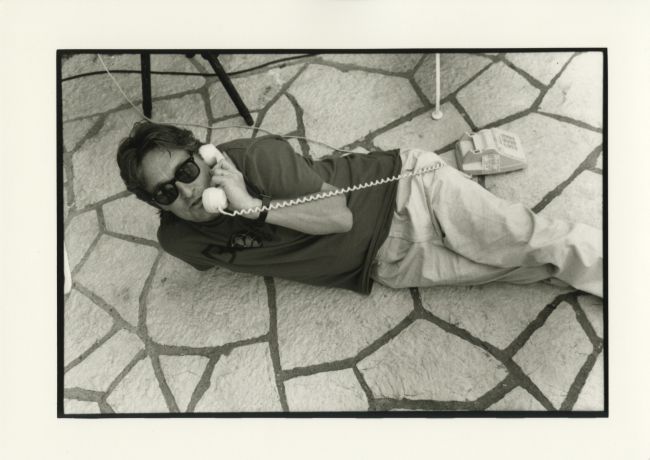
Michael Douglas, Antibes, 1990. © Jean Pigozzi
Do you really believe that collecting art does not change a person?
No. I think it's important that kids in school learn about art. It's very important because it opens up your imagination, your creativity. I have this place in Panama and I see what they teach them in school. They teach them nothing. They teach them how to milk a cow and the history of Panama, which is a hundred years old. But if they would teach drawing or painting, photography, making music, etc., it helps your mind a lot. Not to teach them how to become artists, but to start the morning with a piece of paper and a pencil. You can write a song, you can design a building, you can do a drawing. That is very, very important. Because imagination and creativity cannot be taught, but you can help people develop it. Everybody has some imagination; you just have to help people see it. That's why art is so important. Because people now, when they buy Picasso, they feel that they have a piece of Picasso's imagination in their house. And everyone who comes to their house shares that with them. This is an incredible painting – I own it. Ooo.... And if they stand in line for five hours to go to Lady Gaga's concert, they want to be in the same room and share this experience with 20,000 or more kids to see this woman who has something that they don't have – she sings, she dances, she dresses in a funny way. I think that people who are creative are becoming more and more important. Because one more investment banker, people are not interested in that any more. Look what's happening now with DJs – the best of them are earning a million dollars for two hours of work. Let's say you have a daughter, and one day she says she has a boyfriend who is a DJ. A few years ago you would have wished your daughter had a boyfriend who was an architect or doctor. Now, a DJ, that's very nice! Great! He's a nice boy – I would like to meet him.
So, it's interesting that things are changing like that. It's great, I'm all for artists becoming very rich. Because they have something that other people don't have and that's great.

© Macoto Murayama " Latyrus odoratus L - side view - b", 2009-2012
How did you train yourself to distinguish good art from bad art?
I think I made millions of mistakes. I went to hundreds of museums, I went to hundreds of galleries. I never read, but I look at millions of art books. That's how I learned. It doesn't come in one day; you need a long time. I have no idea whether my eye is good or bad, but it's definitely different. But you have to be very well informed. You have to know what's happening, you have to go to all the galleries, and you have to look at everything starting from Egyptian art.
Is there any possibility that one day your African or Japanese collection will be complete?
No, it's never complete because young artists are coming up all the time. But one day I might say no – no more Africa, no more Japanese, now I'm collecting art from Mongolia. I have no idea. But it can be a possibility, very small, that one day I'll say that I'm only going to collect children's drawings. I always think about new collections. I have a couple of ideas, also about a collection I want to start, but at the moment I think it's a bad idea. You know, I already had a collection that I stopped. You see that carpet behind you, it's a Baluchi carpet from Afghanistan. But they stopped making them. They made them for ten years and then they stopped. So the collection is finished.
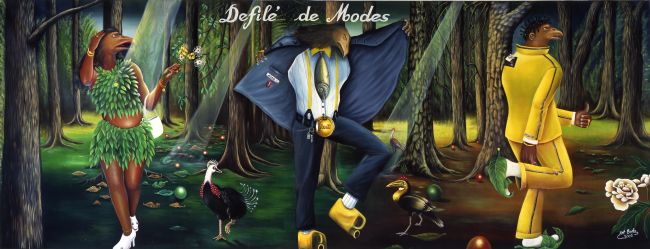
Pierre Bodo. Défilé de modes, 2006
Speaking of carpets. Old Persian rugs – none of them are signed. And it's completely unimportant because you look at them as pure pieces of artwork. Unlike, for example, contemporary art, where a well-known artist's signature automatically adds additional value to a piece of artwork.
It does. But you know, there is a huge difference between art and craft. You can go to craft fairs and the people do incredible things, but it's still craft. And that was a problem with Africa. Everybody said to me that what I am buying is craft. It has nothing to do with craft, but there is lots of confusion. So, Picasso was definitely not a craftsman, OK.
But Jeff Koons? He is a huge factory....
Yes, he is a huge factory in which two hundred people are making his pieces....
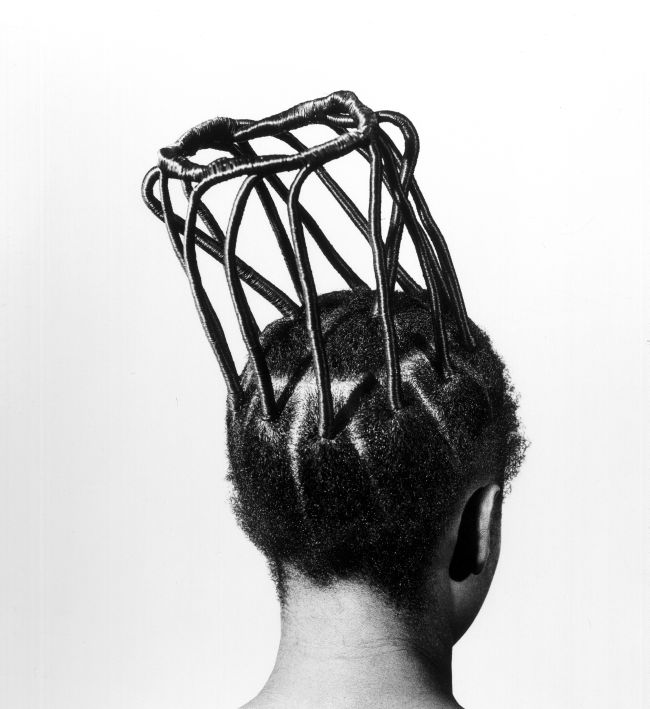
Okhai Ojeikere. "Onile gogoro". Onile gogoro or akaba, 1975/1999
Where, then, is the line between art and craft?
He also copies a lot other stuff.... But you know, when you go to a craft fair there is a lot of stuff that took a lot of time to do, but it's horrible. But people collect baskets woven by Indians and they are not signed, either. I collected pottery for a time, mostly from southern France, and those pieces are also not signed. They are funny and strange. I've stopped that collection; I have almost two hundred pieces. Because when I started buying them, they cost around 20-30 euros; now they cost around 200 euros, so I've stopped.
From your point of view, what makes something a masterpiece?
It's like seeing an incredibly beautiful girl on the beach. She is a masterpiece. Everything is perfect: the length of her legs, her shoulders, her mouth. There are some paintings that are really perfect. Everything is right: the colours, the proportions, the shapes. Some other ones are OK, you can tell. Like Gioconda – whether she is smiling or not smiling, that makes it intriguing, there is something magical about it.... It's the same when you look at any other very powerful painting; you know in an instant that it's a masterpiece. But some other paintings are only 95% perfect; the artist has maybe drawn a strange line, and so on. Like Bacon's triptychs. Some of them, especially those with cardinals, you look at them and think it's incredible stuff. But some of the other ones, they are good, but not as good than that one. There is something that hits you on the head when you see it. It's like with music – every summer there is a hit. Like this summer, it's interesting, there was no hit. There was no popular music that hits everybody. And sometimes there is a song you maybe heard a million times, but everybody loves it. It is a question of getting everything completely right in one piece. It happens.

Chéri Samba. L'espoir fait vivre n°2 (Hope is Living), 1997
Do you have such pieces in your collection?
Yes, I have some paintings that are perfect. And they are really incredible. And some photographs by Keita. There is one of a big black man holding a little baby. It's a perfect picture. There is another one of a very fat lady lying down like that. It's a masterpiece. Bizarrely enough, let's say you have fifty pictures and you show them to fifty people and they all immediately pick out the same picture of the group. You know, it's a miracle. Something is happening there. But it's the same thing with food. Cooks can do one thing incredibly well and people love it. For example, MacDonald's – people love the Big Mac.
Do you really think that's a masterpiece?
Yes, it's a masterpiece. Or look at Coca-Cola, it's a masterpiece of bubbles and sugar. It's a masterpiece all over the world and people love it.
Maybe it's a masterpiece of branding?
Ehhh.... It's difficult to brand something that is not perfect. You can brand as much as you want, but if the product is not really good, you will just be spending a lot of money on it. Look at Red Bull – they have one product and it doesn't taste so good and I never drink it, but, you know, people recognise the masterpiece. And they know that Mick Jagger does his job the best; he has been there for fifty years. And Bono and Madonna – they are people who become masterpieces for what they are. Like Warhol and Picasso.
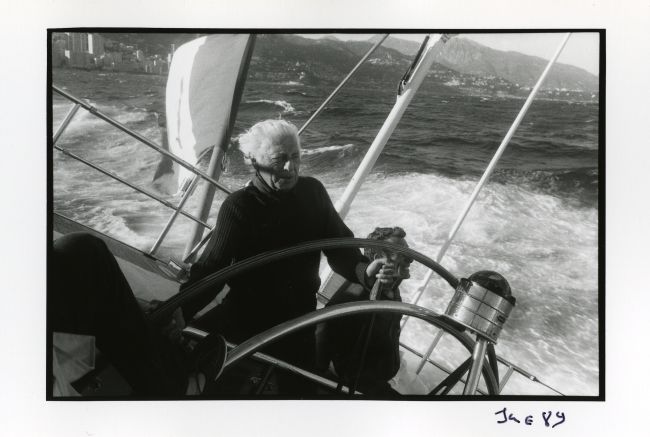
Gianni Agnelli, Monaco, 1989. © Jean Pigozzi
You once named Warhol, Agnelli and Sottsass as your mentors. What did you learn from them?
You know, I was twelve when my father died. I didn't really have a father figure, but I had a few other men in my life. Agnelli was one. Sottsass and Helmut Newton – they were very important because they told me about life. I feel it's very important to have mentors in your life. Like in Japan, there is the master potter and there are some people who watch him for twenty years to see how he is doing the things, and then they become masters themselves. But for twenty years they do nothing, just prepare the clay. And that's very important. I'm sure that Leonardo da Vinci had some guys doing the background work, but they saw the great master do the painting. It's very important to have very intelligent people around you when you are young and to watch how they are doing things. I've learned different things from all of them. Agnelli was the most elegant man I've met in my life and he had a great sense of humour; he was also a great businessman. Jimmy Goldsmith, who has since died, was an outstanding character, a famous businessman and also a person with a wonderful sense of humour. From Ettore Sottsass I learned everything about design and colours. From Helmut Newton I learned everything about photography. From each of them I've learned something different. Now I'm old myself.
And now you feel like a mentor yourself?
Yes. And it's fun now. I have young people around me, which is great. I could never understand why these old men had me around, but now I understand it very well. Because I know nothing about young people's pop culture, I know nothing about music now, etc. It's very important to always have new blood around you, to have younger people around who can show and tell you about new things. I think it's very, very important. You know, it's not only old people, but some young people are old, too. You have to be curious. Every day in your life you have to go out and learn something new. The day when you stop being curious, you can close down your shop, it's finished. If you're interested in new things, if you learn new things, that is what makes your life interesting. And that's why I like finding new art, because it's too easy to go and buy a Warhol or Jeff Koons or Richard Prince. That's not interesting. I'm interested in finding a new Jeff Koons. That's what I don't like about museums. You see, museums, they always want to buy established art. If they want to buy a painting, when they buy it it costs ten million dollars, but if they had bought it ten years ago it might have cost around 10,000 dollars. I've talked about this with museums and they say, you know, we can't make mistakes. Come on, we all make mistakes! If it's not a good painting – by the way, they all have warehouses with 100,000 paintings – they can give it to a hospital or a school or they can burn it if they really hate it. But they should buy it. Then they say we really need to buy this painting, it's so important for the collection...it's 20 million dollars. OK, with 20 million dollars you can buy a lot of paintings, a lot of young painters for 3000-4000 dollars. And a lot of good paintings. But they don't do that, because they are scared. All the curators are so proud – oh, I bought this. I said, look John, you bought ten horrible paintings this year but, you know, I bought one...and it's gonna be the new Picasso.

Bodys Isek Kingelez. Ville Fantôme, 1996
What are they afraid of – losing their jobs?
Losing their jobs, about other people. It's also more work. You have to walk around and go to some young guy's horrible, cold little atelier. If you're going to big, air-conditioned spaces where people are wearing Armani suits, it's easier. You have to work hard and they don’t like to do that.
There's currently a big debate about the new Guggenheim museum in Helsinki. Many people from the local art scene are against the project. They think the Guggenheim will only display its very authoritative art collection and ignore the local art scene.
I agree. I completely agree. I think there should be more and more shows of very young artists, and then 90% of the show will be bad but a couple of the pieces will be good. I know nothing about the young art scene in Helsinki, but I'm sure that there are at least one or two good painters. And I'm sure there are a lot of bad ones. You see, 99% of painters and artists are bad. But one of them is good, and that's OK. And then the fashion goes up and down. If you look at the price of Richard Prince – he was incredibly hot three years ago, now he is not so hot, but maybe he'll come back. So, it's OK. But this doesn't mean he was bad then, or that he is not so good now, or that he is better now than back then.... It means nothing. It means that somebody else has arrived. When Murakami appeared, everyone then wanted him. It's a very strange thing. But that's a part I'm not interested in at all. I buy my little things and I try to put a collection together. And I stick with what I do. I'm looking at everything else that's happening, but I'm very focused on what I'm interested in.
When you are taking pictures, do you feel like an artist yourself?
Yes. I take it very seriously. I've been taking pictures from the age of twelve. I think my photography will be very important in a hundred years' time. Because I've been recording a specific period in bourgeois life. I don't go to war zones or central Africa. I don't take pictures of lions eating antelopes. I'm just taking pictures around me. But my life is kind of interesting and fun. And I'm taking pictures of everything around me. And in a hundred years' time people will wonder how people lived in 2010 or how they lived in 1975. I will have an incredible record of all that, which I think will be very interesting. The pictures I take are kind of sophisticated snapshots; I hate posed pictures.
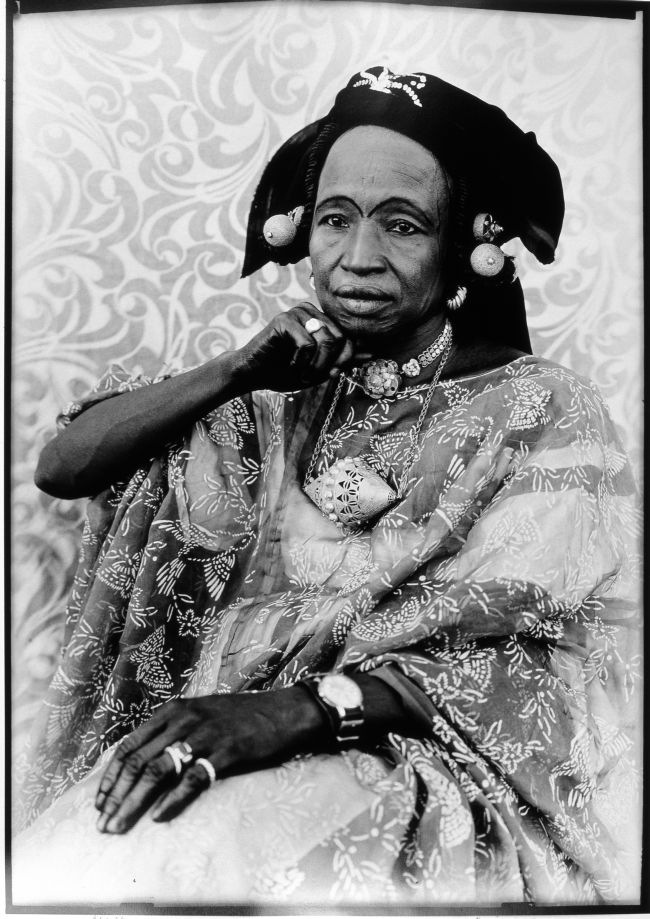
Seydou Keita. Untitled, 1954
What fascinates you about photography?
I'm obsessed with recording things. If I was a great writer, like Proust, I would write. But I'm a mediocre writer, so I take pictures of everything around me. And in a slightly better way than other people. I will show you something.... (Pigozzi opens his small iPad with its well-worn yellow cover.) This is a picture I took of Steve Jobs in 1983. Steve is giving the finger to IBM. I was out on the street with Steve and we were just walking around. This is a historical picture now. And this was last week – it's Bono and Larry Gagosian.... That's Bono.... At his house. Very simple pictures. These are the kind of pictures I'm interested in. Being very close to very famous people. These pictures I took in 1980 in China.
All of them are black and white?
Always. And there is a reason for that. The world is not in black and white. It's more precise. But these are very interesting pictures. This is an art school in China. I went there with Sol Lewitt in January 1980. The students were drawing a model, and then we saw this painting, and we both – Sol Lewitt and I – we said it's incredible, it's like a Jackson Pollock! And they do abstract art there. The guide was laughing. I said, “Why you are laughing?” He said, “You will see.” And then trrrr, the bell rang, the end of school and everyone ran to clean their brushes. This was the place where they cleaned their brushes. Afterwards, somebody was writing an article about this trip I took with Sol Lewitt and how we thought that we were seeing abstract art. I like taking pictures all the time.
Someone also wrote about you that, since you were taking selfies long before they became popular, maybe you actually invented them.
I think it's possible that I invented the selfie. It's possible. Because one of my first selfies is from 1975 or 1976.
But why do you think it was you? Why you are so sure?
I had never seen one before. And I tell you why, because I have long arms and I can do like that.... But, of course, I can't be completely sure. There was recently an article in the Los Angeles Times that said the first selfie showed up in 1991. But I was taking them more than ten years before then.
Why do you think people are so obsessed with selfies now?
Usually, when people meet somebody famous they ask for an autograph. But that doesn't mean that they've really met the person. When you have a selfie, that's proof. That's what it is. And I think people are more interested in themselves. A lot of selfies are with celebrities, but people also post pictures of themselves skiing, jumping, etc. But what I find really interesting is Instagram. It's fun to see what people post. Some of them are great, some of them are horrible. I don't like Instagram of food and children, but some people post some interesting things. Have you seen my Instagram? It's a little bit different. I like to tell stories. For example, there is a story about me being kidnapped, being lost somewhere.... What I find interesting is to be creative on a very small scale. It's not easy. And only a few people manage to do so.
Your friend film director Brett Ratner once described you as “pathologically happy”.
I'm not always happy, but I try. I try to be happy. If I'm not happy, who else will be happy?